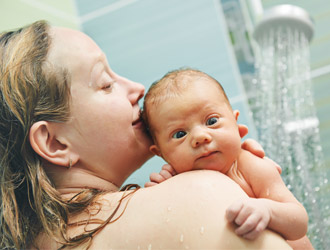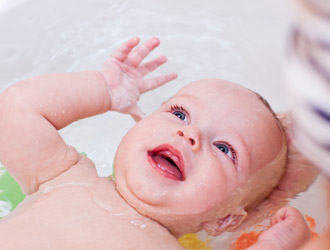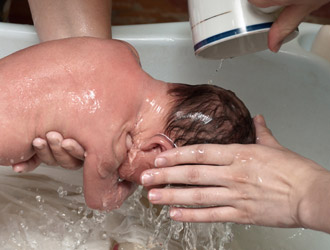Home Development Program
 Overview
Overview
Download and print
Now you can download a printable copy of our Home Development Program and keep it handy during bath time!
Click here to download
The object of this program is to instruct new parents in what to do with their newborn baby in order to prepare your baby for the development of their Personal Aquatic Survival Skills (PASS).
Babies spend the first 40 weeks of their lives immersed in a fluid, so they are very familiar with a liquid environment and the effects it has on their body. For all intents and purposes, they have been floating for 40 weeks, and any experienced swimming teacher will tell you that getting a child to trust the water and float on or in it is normally the first big challenge both pupil and teacher face.
Babies already have this skill. The challenge is to make sure the baby, after they are born continues to develop this skill. You can start as soon as baby's first bath, but if you don't feel comfortable, try not to leave it too long, as the idea is to take advantage of baby's memory of feeling weightless while it is still fresh in their mind.
Of course the biggest difference to being in the uterus and out in the world is the baby now has to breathe to live as opposed to receiving oxygen through the umbilical cord. This changes the whole dynamics of how they adapt to the water environment they encounter outside the womb.
Aims
The aims of the (PASS) home development programs are as follows:
- Make bath time fun
- Maintain baby's ability to float on top of or in the water
- Develop the baby's breath control
1. Make bathtime fun
First and foremost bathtime needs to be fun and an enjoyable experience, so the golden rule is to avoid any activities where your baby starts to get stressed. At the beginning of bath time, play with your baby and make them feel comfortable and relaxed. The water should be warm, around body temperature.
2. Maintain baby's ability to float in water
 Because the baby cannot put their face in the water at this stage, this activity needs to be carried out while the baby is lying on their back.
Because the baby cannot put their face in the water at this stage, this activity needs to be carried out while the baby is lying on their back.
Place one hand under the back of the baby's head and shoulders and the other hand under their bottom. Gently lower the baby (face up) into the water. The aim is to lower the baby until the water touches the corner of their eyes and mouth. Their ears will be completely covered by the water.
Once the water gets to the corner of their eyes and mouth you should feel the baby start to become weightless. Please do not attempt to let the baby float by themselves at this stage. Always support the baby with your hands. If at any stage during the lowering process the baby starts to get upset raise them back up out of the water, kiss and cuddle them and then repeat the lowering process. Spend about two to three minutes on this activity, longer when you become more comfortable and baby is happy. Remember do not try to force the baby past the point where they are comfortable.
You are now reminding your baby that the water is an environment where they are weightless. Most babies are relaxed with this activity.
3. Develop the baby's breath control
Now that the baby has to rely on air when they breathe as opposed to sharing the mother's oxygen supply, they have to learn to hold their breath when their nose and mouth are covered with water.
An effective way to help the baby know when this is going to happen is to develop a trigger command. This is simply a word or phrase that lets the baby know water is going to flow around their nose, mouth, eyes and ears.
 This is what you do. Hold the baby securely so their shoulders are low in the water and they are facing down. Wet the babies head with your hand so that what hair they may have is totally saturated. Use a small plastic cup, and place a small amount of water (approx. 10mm) in the bottom of the cup. Call the baby by name, then use the trigger command, and then pour the water over the top of the babies head so that small amounts of water run over and around the baby's eyes, nose and mouth.
This is what you do. Hold the baby securely so their shoulders are low in the water and they are facing down. Wet the babies head with your hand so that what hair they may have is totally saturated. Use a small plastic cup, and place a small amount of water (approx. 10mm) in the bottom of the cup. Call the baby by name, then use the trigger command, and then pour the water over the top of the babies head so that small amounts of water run over and around the baby's eyes, nose and mouth.
So the process goes like this:
- Wet the baby's hair
- Call the baby by name (James)
- Use the trigger command '1-2-3-under'
- As soon as you say 'under'
- Pour the water over the head.
Repeat this process several times. As the baby gets used to the trigger command and the water going over their head, you can increase the amount of water in the cup. Over a period of time you can build up to a full cup of water over the baby's head, which means the baby will now have to hold their breath for a slow count of one-two-three (about three seconds). Keep in mind the first turn will only be for one second.
In this activity you are teaching your baby two things: A trigger command and how to hold their breath for longer periods of time.
Once you feel your baby is used to the trigger command, you can start to phase it out. First, shorten the trigger command by leaving out the “1-2-3” phrase, so it becomes “James (slight pause) Under.” You will be surprised how quickly your baby will adjust to this new command. Then, when baby is comfortable with that command, you can shorten it to simply say, “Under,” and then pour the water over the baby’s head. Finally, when baby is comfortable, remove all trigger commands and simply pour the water over baby’s head; they will control their breathing.
Remember to be patient, phase out the trigger command over a period of time, be guided by your baby’s reaction and always back away if your baby starts to get distressed.
Whats next?
The same old routine I'm afraid except now baby is big enough to go into the shower but the following still apply:
- Make shower time fun
- Maintain baby's ability to float on top of or in the water
- Develop the baby's breath control
You will still have to use the bath for “Maintaining baby's ability to float in water” as you need a fixed body of water in which to perform this step, however for the other two skills, the shower can become a great learning ground.
Of course you still have to make it fun and give the baby lots of encouragement, kisses, cuddles and laughter to set the mood.
 The shower is a great tool for really developing the baby's breath control. Hold the baby facing you to your chest with the shower rose pouring water over your back. Use the same trigger command “1-2-3-under” and as you say “under” turn around and let the water run over the back of the baby's head so that a stream goes over and around the baby's eyes, nose, mouth and ears.
The shower is a great tool for really developing the baby's breath control. Hold the baby facing you to your chest with the shower rose pouring water over your back. Use the same trigger command “1-2-3-under” and as you say “under” turn around and let the water run over the back of the baby's head so that a stream goes over and around the baby's eyes, nose, mouth and ears.
Once again employ a slow count while the water is flowing over the back of the baby's head. Build up this skill over time to a slow count to five. The aim is to teach the baby to hold their breath for a slow count of five. Practice with a time piece so you get used to counting off five seconds. You will be surprised how long this feels especially if you are a first time parent.
If you do not have a shower then you can use a one litre container to pour water over the baby's head while they are in the bath. It does not matter if it is the shower or bath, what matters is you are teaching the baby how to hold their breath.
Summary
Your aim is to ensure your baby does not lose the skills they are born with in relation to what it feels like to be weightless in a water environment.
The skill you need to maintain is their floating skill and the new skill you need to teach them is how to hold their breath while water is flowing over and around their ears, eyes, nose and mouth.
Make bath/shower time a fun activity and never force your baby to do a skill they are not happy with. Back off if your baby becomes unhappy with an activity, and then gradually build back up to the point where the baby is happy again, and then work through that point.
Please enjoy this wonderful experience with your baby as you re-introduce your child to some familiar aquatic skills and the new skill of being able to control their breathing when water goes over their face.
Relax and have fun.
Chris Shapland.
-
Back to Swim Programs
Next Babies Program
Booking request
Latest News
OPEN with COVID SAFE practices
Approved Covid Safe Plan. Regular Deep Cleaning. AHPPC (Australian Health Protection Principal...
Make up lessons
At Shaplands’ we have a philosophy that you get the number of lessons you pay for and since 1992...
Testimonials
Amazing review from Mandy
I would like to put in writing my appreciation for administrative and swim instructor team at Warner...
6 years of fabulous swimming lessons
After 6 years of fabulous swimming lessons with you without a single break, thanks for all that you have...
Just started and very impressed
Ted started with you 3 weeks ago and i just wanted to say I am beyond impressed with your school and in...


